Cross Cultural Management: Cultural Adaptation in Global Organizations
VerifiedAdded on 2023/06/05
|8
|1812
|198
Essay
AI Summary
This essay delves into the critical aspects of cross-cultural management and adaptation within the context of global business environments. It examines the challenges and strategies for individuals and organizations navigating diverse cultural landscapes, emphasizing the importance of cultural competence, empathetic responsiveness, and effective communication. The essay analyzes various perspectives from different media articles, contrasting their approaches to understanding cultural divergences and fostering culturally efficient organizations. Furthermore, it highlights the role of global leadership attributes in multicultural teams and the significance of adapting pedagogical approaches to accommodate both national and international learners. The discussion underscores the need for businesses to value cultural differences, promote innovation, and cultivate strong intercultural relationships to achieve sustainable success in an increasingly interconnected world. Access more study resources and solved assignments on Desklib.

Running head: CROSS CULTURAL MANAGEMENT
CROSS CULTURAL MANAGEMENT
Name of the Student:
Name of the University:
Author note:
CROSS CULTURAL MANAGEMENT
Name of the Student:
Name of the University:
Author note:
Paraphrase This Document
Need a fresh take? Get an instant paraphrase of this document with our AI Paraphraser
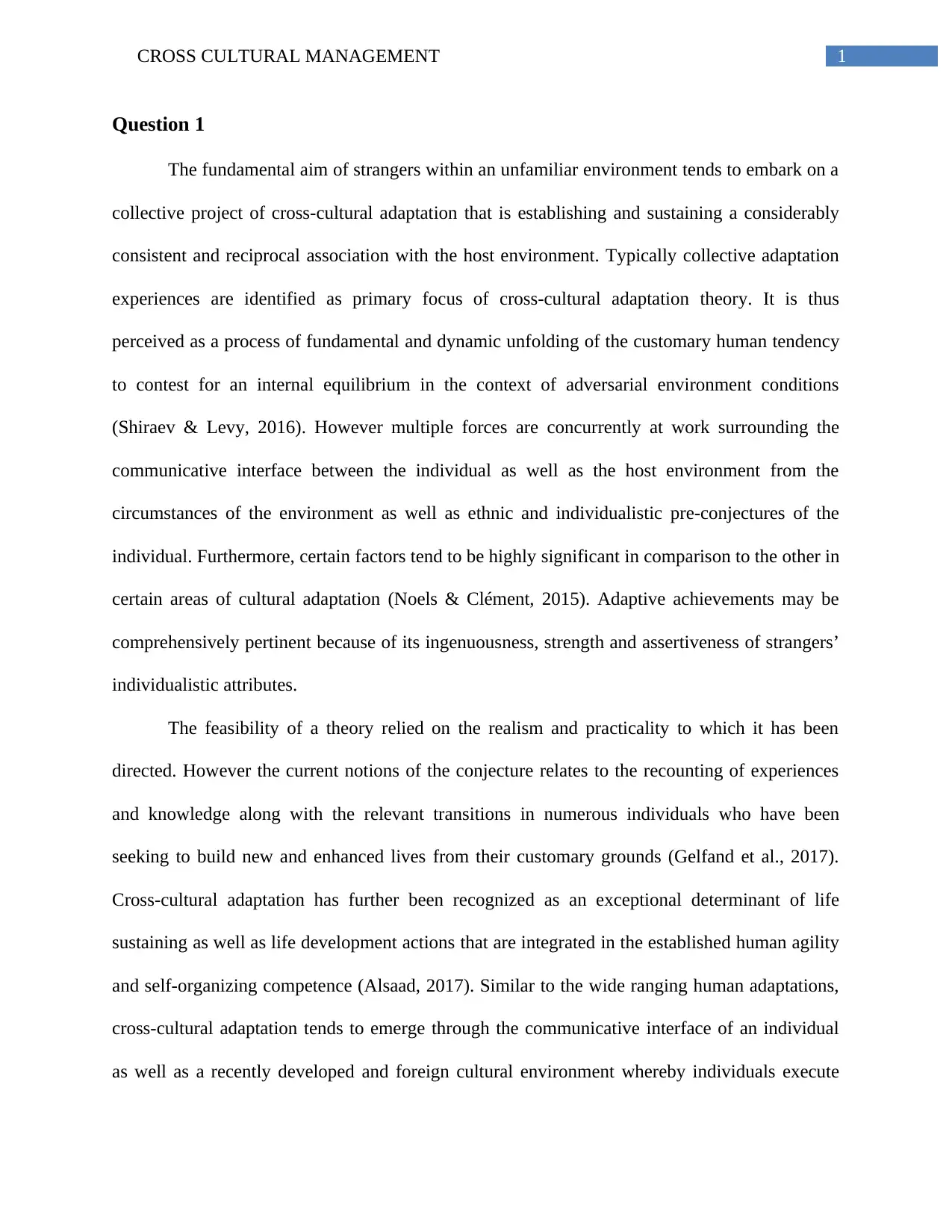
1CROSS CULTURAL MANAGEMENT
Question 1
The fundamental aim of strangers within an unfamiliar environment tends to embark on a
collective project of cross-cultural adaptation that is establishing and sustaining a considerably
consistent and reciprocal association with the host environment. Typically collective adaptation
experiences are identified as primary focus of cross-cultural adaptation theory. It is thus
perceived as a process of fundamental and dynamic unfolding of the customary human tendency
to contest for an internal equilibrium in the context of adversarial environment conditions
(Shiraev & Levy, 2016). However multiple forces are concurrently at work surrounding the
communicative interface between the individual as well as the host environment from the
circumstances of the environment as well as ethnic and individualistic pre-conjectures of the
individual. Furthermore, certain factors tend to be highly significant in comparison to the other in
certain areas of cultural adaptation (Noels & Clément, 2015). Adaptive achievements may be
comprehensively pertinent because of its ingenuousness, strength and assertiveness of strangers’
individualistic attributes.
The feasibility of a theory relied on the realism and practicality to which it has been
directed. However the current notions of the conjecture relates to the recounting of experiences
and knowledge along with the relevant transitions in numerous individuals who have been
seeking to build new and enhanced lives from their customary grounds (Gelfand et al., 2017).
Cross-cultural adaptation has further been recognized as an exceptional determinant of life
sustaining as well as life development actions that are integrated in the established human agility
and self-organizing competence (Alsaad, 2017). Similar to the wide ranging human adaptations,
cross-cultural adaptation tends to emerge through the communicative interface of an individual
as well as a recently developed and foreign cultural environment whereby individuals execute
Question 1
The fundamental aim of strangers within an unfamiliar environment tends to embark on a
collective project of cross-cultural adaptation that is establishing and sustaining a considerably
consistent and reciprocal association with the host environment. Typically collective adaptation
experiences are identified as primary focus of cross-cultural adaptation theory. It is thus
perceived as a process of fundamental and dynamic unfolding of the customary human tendency
to contest for an internal equilibrium in the context of adversarial environment conditions
(Shiraev & Levy, 2016). However multiple forces are concurrently at work surrounding the
communicative interface between the individual as well as the host environment from the
circumstances of the environment as well as ethnic and individualistic pre-conjectures of the
individual. Furthermore, certain factors tend to be highly significant in comparison to the other in
certain areas of cultural adaptation (Noels & Clément, 2015). Adaptive achievements may be
comprehensively pertinent because of its ingenuousness, strength and assertiveness of strangers’
individualistic attributes.
The feasibility of a theory relied on the realism and practicality to which it has been
directed. However the current notions of the conjecture relates to the recounting of experiences
and knowledge along with the relevant transitions in numerous individuals who have been
seeking to build new and enhanced lives from their customary grounds (Gelfand et al., 2017).
Cross-cultural adaptation has further been recognized as an exceptional determinant of life
sustaining as well as life development actions that are integrated in the established human agility
and self-organizing competence (Alsaad, 2017). Similar to the wide ranging human adaptations,
cross-cultural adaptation tends to emerge through the communicative interface of an individual
as well as a recently developed and foreign cultural environment whereby individuals execute
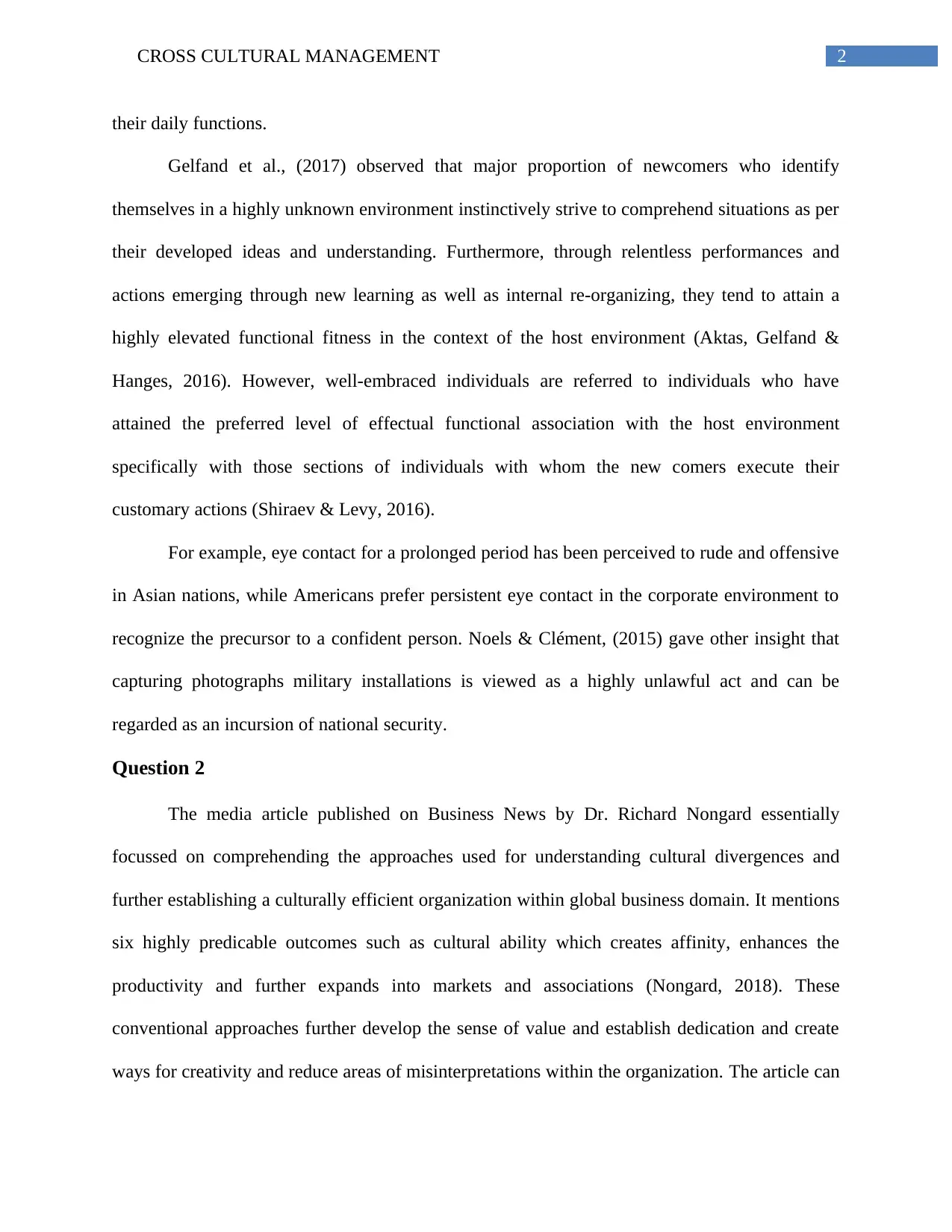
2CROSS CULTURAL MANAGEMENT
their daily functions.
Gelfand et al., (2017) observed that major proportion of newcomers who identify
themselves in a highly unknown environment instinctively strive to comprehend situations as per
their developed ideas and understanding. Furthermore, through relentless performances and
actions emerging through new learning as well as internal re-organizing, they tend to attain a
highly elevated functional fitness in the context of the host environment (Aktas, Gelfand &
Hanges, 2016). However, well-embraced individuals are referred to individuals who have
attained the preferred level of effectual functional association with the host environment
specifically with those sections of individuals with whom the new comers execute their
customary actions (Shiraev & Levy, 2016).
For example, eye contact for a prolonged period has been perceived to rude and offensive
in Asian nations, while Americans prefer persistent eye contact in the corporate environment to
recognize the precursor to a confident person. Noels & Clément, (2015) gave other insight that
capturing photographs military installations is viewed as a highly unlawful act and can be
regarded as an incursion of national security.
Question 2
The media article published on Business News by Dr. Richard Nongard essentially
focussed on comprehending the approaches used for understanding cultural divergences and
further establishing a culturally efficient organization within global business domain. It mentions
six highly predicable outcomes such as cultural ability which creates affinity, enhances the
productivity and further expands into markets and associations (Nongard, 2018). These
conventional approaches further develop the sense of value and establish dedication and create
ways for creativity and reduce areas of misinterpretations within the organization. The article can
their daily functions.
Gelfand et al., (2017) observed that major proportion of newcomers who identify
themselves in a highly unknown environment instinctively strive to comprehend situations as per
their developed ideas and understanding. Furthermore, through relentless performances and
actions emerging through new learning as well as internal re-organizing, they tend to attain a
highly elevated functional fitness in the context of the host environment (Aktas, Gelfand &
Hanges, 2016). However, well-embraced individuals are referred to individuals who have
attained the preferred level of effectual functional association with the host environment
specifically with those sections of individuals with whom the new comers execute their
customary actions (Shiraev & Levy, 2016).
For example, eye contact for a prolonged period has been perceived to rude and offensive
in Asian nations, while Americans prefer persistent eye contact in the corporate environment to
recognize the precursor to a confident person. Noels & Clément, (2015) gave other insight that
capturing photographs military installations is viewed as a highly unlawful act and can be
regarded as an incursion of national security.
Question 2
The media article published on Business News by Dr. Richard Nongard essentially
focussed on comprehending the approaches used for understanding cultural divergences and
further establishing a culturally efficient organization within global business domain. It mentions
six highly predicable outcomes such as cultural ability which creates affinity, enhances the
productivity and further expands into markets and associations (Nongard, 2018). These
conventional approaches further develop the sense of value and establish dedication and create
ways for creativity and reduce areas of misinterpretations within the organization. The article can
⊘ This is a preview!⊘
Do you want full access?
Subscribe today to unlock all pages.

Trusted by 1+ million students worldwide
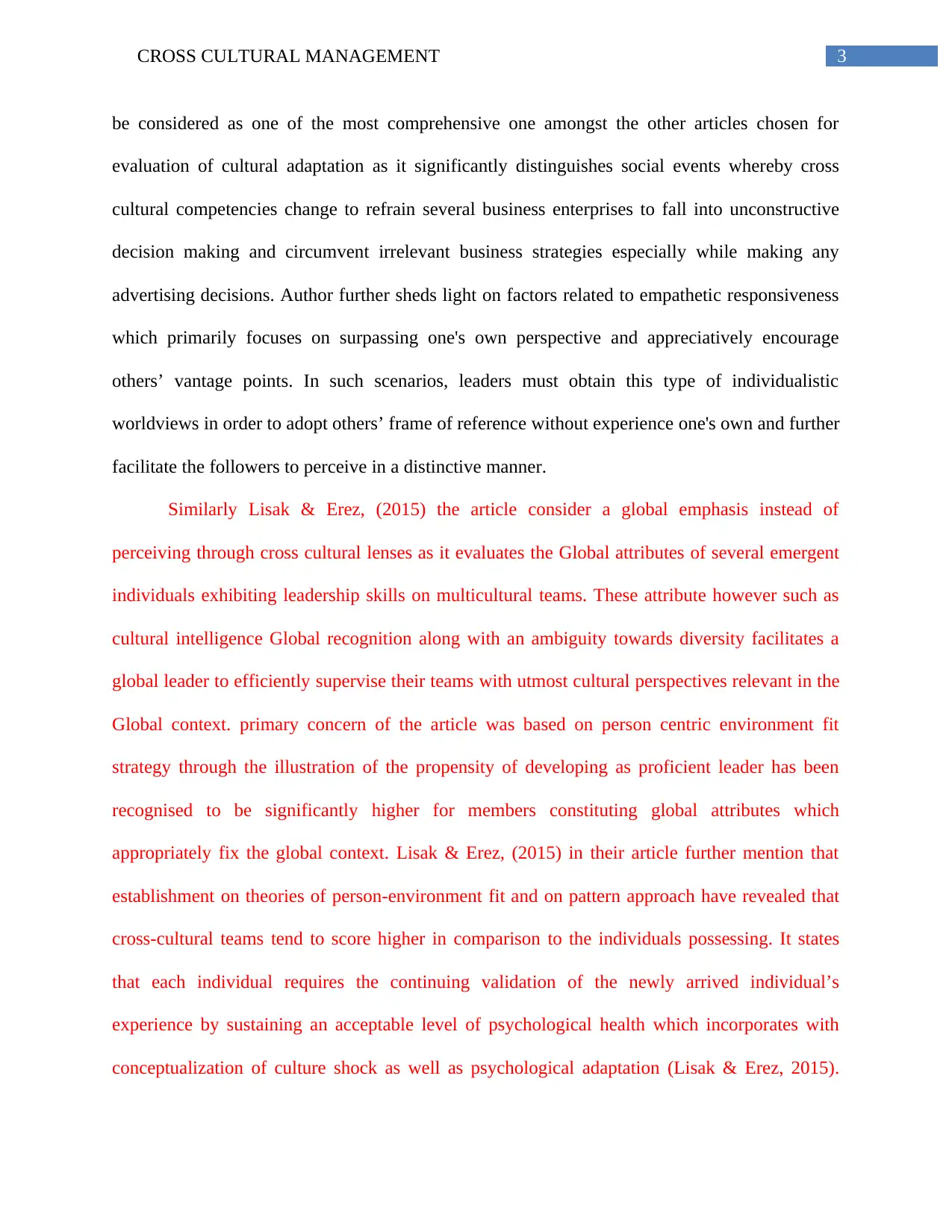
3CROSS CULTURAL MANAGEMENT
be considered as one of the most comprehensive one amongst the other articles chosen for
evaluation of cultural adaptation as it significantly distinguishes social events whereby cross
cultural competencies change to refrain several business enterprises to fall into unconstructive
decision making and circumvent irrelevant business strategies especially while making any
advertising decisions. Author further sheds light on factors related to empathetic responsiveness
which primarily focuses on surpassing one's own perspective and appreciatively encourage
others’ vantage points. In such scenarios, leaders must obtain this type of individualistic
worldviews in order to adopt others’ frame of reference without experience one's own and further
facilitate the followers to perceive in a distinctive manner.
Similarly Lisak & Erez, (2015) the article consider a global emphasis instead of
perceiving through cross cultural lenses as it evaluates the Global attributes of several emergent
individuals exhibiting leadership skills on multicultural teams. These attribute however such as
cultural intelligence Global recognition along with an ambiguity towards diversity facilitates a
global leader to efficiently supervise their teams with utmost cultural perspectives relevant in the
Global context. primary concern of the article was based on person centric environment fit
strategy through the illustration of the propensity of developing as proficient leader has been
recognised to be significantly higher for members constituting global attributes which
appropriately fix the global context. Lisak & Erez, (2015) in their article further mention that
establishment on theories of person-environment fit and on pattern approach have revealed that
cross-cultural teams tend to score higher in comparison to the individuals possessing. It states
that each individual requires the continuing validation of the newly arrived individual’s
experience by sustaining an acceptable level of psychological health which incorporates with
conceptualization of culture shock as well as psychological adaptation (Lisak & Erez, 2015).
be considered as one of the most comprehensive one amongst the other articles chosen for
evaluation of cultural adaptation as it significantly distinguishes social events whereby cross
cultural competencies change to refrain several business enterprises to fall into unconstructive
decision making and circumvent irrelevant business strategies especially while making any
advertising decisions. Author further sheds light on factors related to empathetic responsiveness
which primarily focuses on surpassing one's own perspective and appreciatively encourage
others’ vantage points. In such scenarios, leaders must obtain this type of individualistic
worldviews in order to adopt others’ frame of reference without experience one's own and further
facilitate the followers to perceive in a distinctive manner.
Similarly Lisak & Erez, (2015) the article consider a global emphasis instead of
perceiving through cross cultural lenses as it evaluates the Global attributes of several emergent
individuals exhibiting leadership skills on multicultural teams. These attribute however such as
cultural intelligence Global recognition along with an ambiguity towards diversity facilitates a
global leader to efficiently supervise their teams with utmost cultural perspectives relevant in the
Global context. primary concern of the article was based on person centric environment fit
strategy through the illustration of the propensity of developing as proficient leader has been
recognised to be significantly higher for members constituting global attributes which
appropriately fix the global context. Lisak & Erez, (2015) in their article further mention that
establishment on theories of person-environment fit and on pattern approach have revealed that
cross-cultural teams tend to score higher in comparison to the individuals possessing. It states
that each individual requires the continuing validation of the newly arrived individual’s
experience by sustaining an acceptable level of psychological health which incorporates with
conceptualization of culture shock as well as psychological adaptation (Lisak & Erez, 2015).
Paraphrase This Document
Need a fresh take? Get an instant paraphrase of this document with our AI Paraphraser
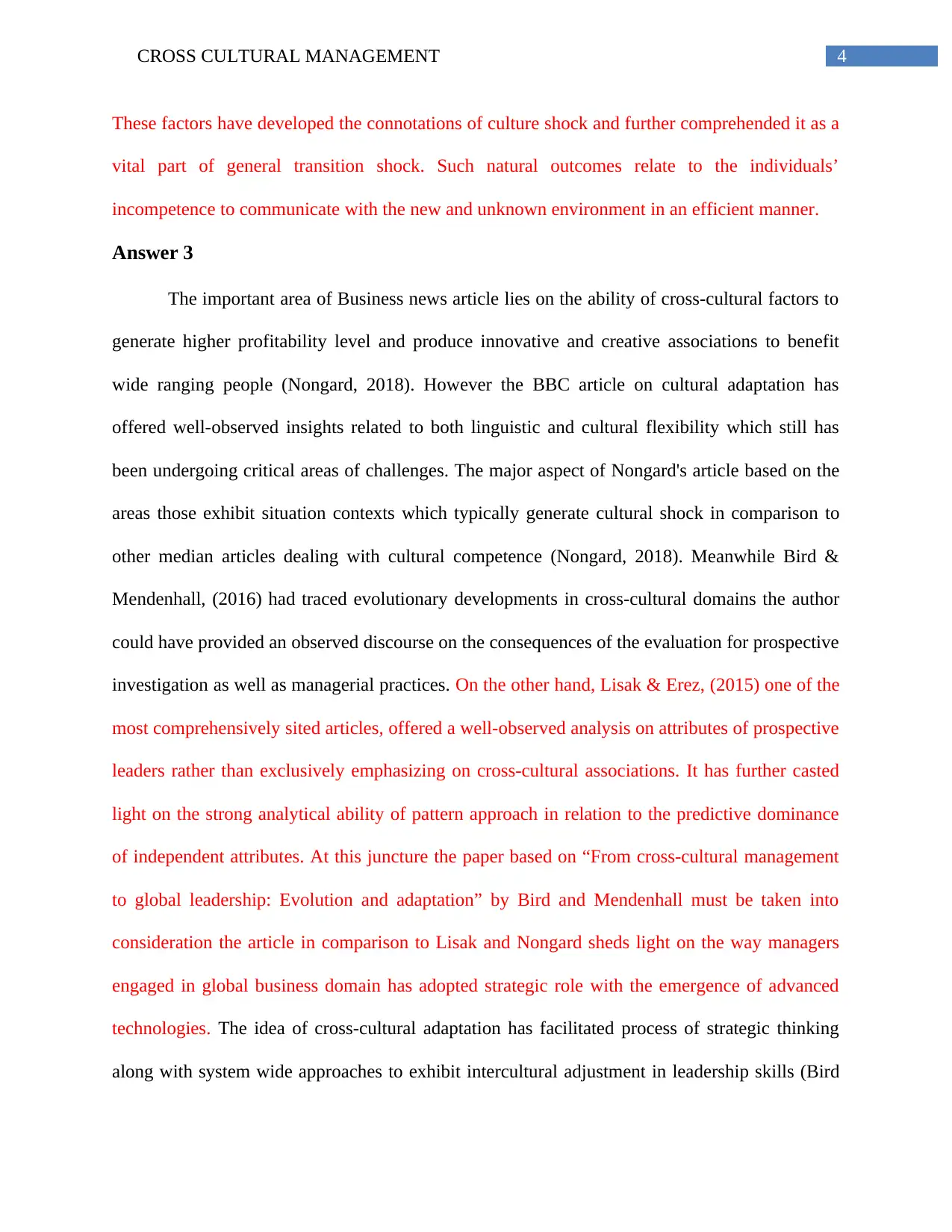
4CROSS CULTURAL MANAGEMENT
These factors have developed the connotations of culture shock and further comprehended it as a
vital part of general transition shock. Such natural outcomes relate to the individuals’
incompetence to communicate with the new and unknown environment in an efficient manner.
Answer 3
The important area of Business news article lies on the ability of cross-cultural factors to
generate higher profitability level and produce innovative and creative associations to benefit
wide ranging people (Nongard, 2018). However the BBC article on cultural adaptation has
offered well-observed insights related to both linguistic and cultural flexibility which still has
been undergoing critical areas of challenges. The major aspect of Nongard's article based on the
areas those exhibit situation contexts which typically generate cultural shock in comparison to
other median articles dealing with cultural competence (Nongard, 2018). Meanwhile Bird &
Mendenhall, (2016) had traced evolutionary developments in cross-cultural domains the author
could have provided an observed discourse on the consequences of the evaluation for prospective
investigation as well as managerial practices. On the other hand, Lisak & Erez, (2015) one of the
most comprehensively sited articles, offered a well-observed analysis on attributes of prospective
leaders rather than exclusively emphasizing on cross-cultural associations. It has further casted
light on the strong analytical ability of pattern approach in relation to the predictive dominance
of independent attributes. At this juncture the paper based on “From cross-cultural management
to global leadership: Evolution and adaptation” by Bird and Mendenhall must be taken into
consideration the article in comparison to Lisak and Nongard sheds light on the way managers
engaged in global business domain has adopted strategic role with the emergence of advanced
technologies. The idea of cross-cultural adaptation has facilitated process of strategic thinking
along with system wide approaches to exhibit intercultural adjustment in leadership skills (Bird
These factors have developed the connotations of culture shock and further comprehended it as a
vital part of general transition shock. Such natural outcomes relate to the individuals’
incompetence to communicate with the new and unknown environment in an efficient manner.
Answer 3
The important area of Business news article lies on the ability of cross-cultural factors to
generate higher profitability level and produce innovative and creative associations to benefit
wide ranging people (Nongard, 2018). However the BBC article on cultural adaptation has
offered well-observed insights related to both linguistic and cultural flexibility which still has
been undergoing critical areas of challenges. The major aspect of Nongard's article based on the
areas those exhibit situation contexts which typically generate cultural shock in comparison to
other median articles dealing with cultural competence (Nongard, 2018). Meanwhile Bird &
Mendenhall, (2016) had traced evolutionary developments in cross-cultural domains the author
could have provided an observed discourse on the consequences of the evaluation for prospective
investigation as well as managerial practices. On the other hand, Lisak & Erez, (2015) one of the
most comprehensively sited articles, offered a well-observed analysis on attributes of prospective
leaders rather than exclusively emphasizing on cross-cultural associations. It has further casted
light on the strong analytical ability of pattern approach in relation to the predictive dominance
of independent attributes. At this juncture the paper based on “From cross-cultural management
to global leadership: Evolution and adaptation” by Bird and Mendenhall must be taken into
consideration the article in comparison to Lisak and Nongard sheds light on the way managers
engaged in global business domain has adopted strategic role with the emergence of advanced
technologies. The idea of cross-cultural adaptation has facilitated process of strategic thinking
along with system wide approaches to exhibit intercultural adjustment in leadership skills (Bird
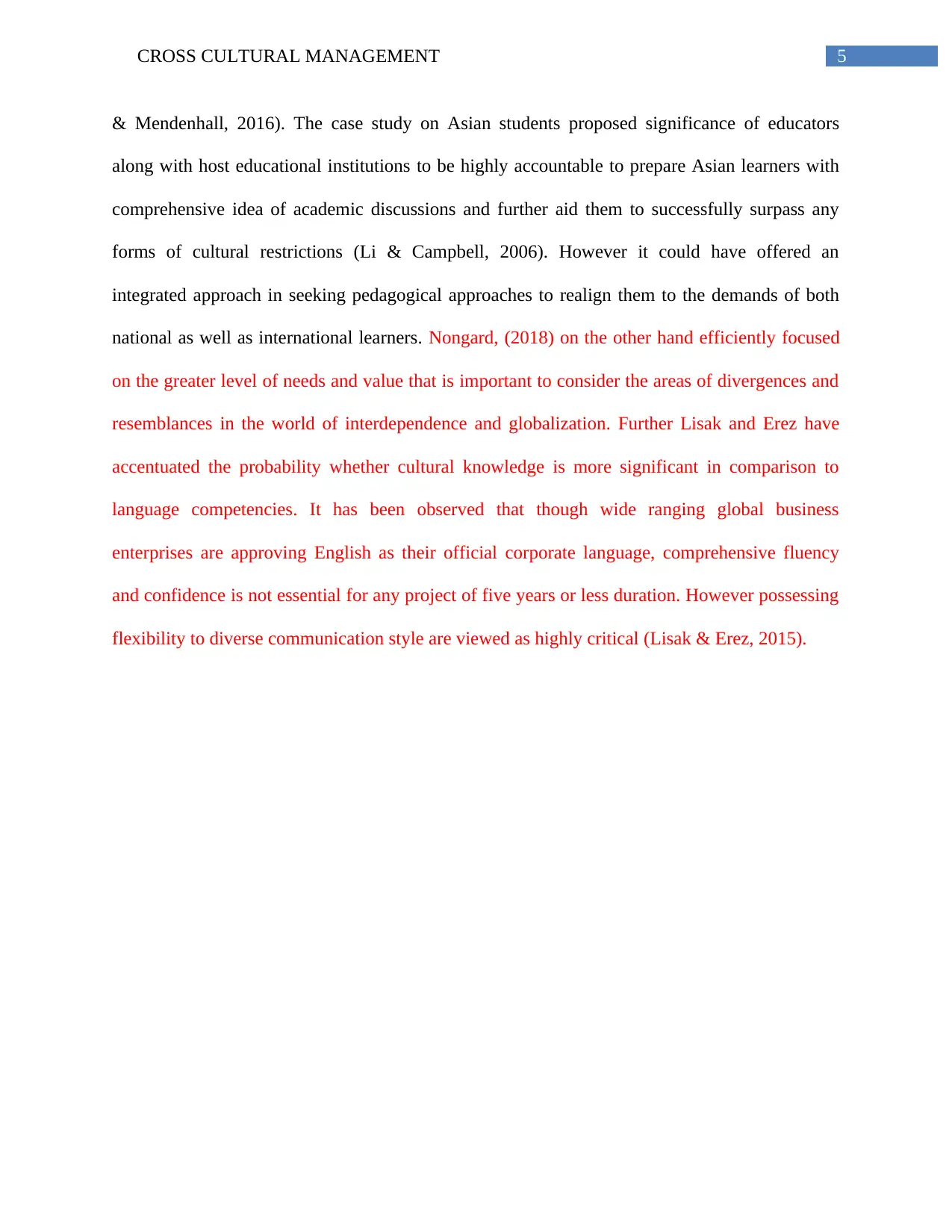
5CROSS CULTURAL MANAGEMENT
& Mendenhall, 2016). The case study on Asian students proposed significance of educators
along with host educational institutions to be highly accountable to prepare Asian learners with
comprehensive idea of academic discussions and further aid them to successfully surpass any
forms of cultural restrictions (Li & Campbell, 2006). However it could have offered an
integrated approach in seeking pedagogical approaches to realign them to the demands of both
national as well as international learners. Nongard, (2018) on the other hand efficiently focused
on the greater level of needs and value that is important to consider the areas of divergences and
resemblances in the world of interdependence and globalization. Further Lisak and Erez have
accentuated the probability whether cultural knowledge is more significant in comparison to
language competencies. It has been observed that though wide ranging global business
enterprises are approving English as their official corporate language, comprehensive fluency
and confidence is not essential for any project of five years or less duration. However possessing
flexibility to diverse communication style are viewed as highly critical (Lisak & Erez, 2015).
& Mendenhall, 2016). The case study on Asian students proposed significance of educators
along with host educational institutions to be highly accountable to prepare Asian learners with
comprehensive idea of academic discussions and further aid them to successfully surpass any
forms of cultural restrictions (Li & Campbell, 2006). However it could have offered an
integrated approach in seeking pedagogical approaches to realign them to the demands of both
national as well as international learners. Nongard, (2018) on the other hand efficiently focused
on the greater level of needs and value that is important to consider the areas of divergences and
resemblances in the world of interdependence and globalization. Further Lisak and Erez have
accentuated the probability whether cultural knowledge is more significant in comparison to
language competencies. It has been observed that though wide ranging global business
enterprises are approving English as their official corporate language, comprehensive fluency
and confidence is not essential for any project of five years or less duration. However possessing
flexibility to diverse communication style are viewed as highly critical (Lisak & Erez, 2015).
⊘ This is a preview!⊘
Do you want full access?
Subscribe today to unlock all pages.

Trusted by 1+ million students worldwide
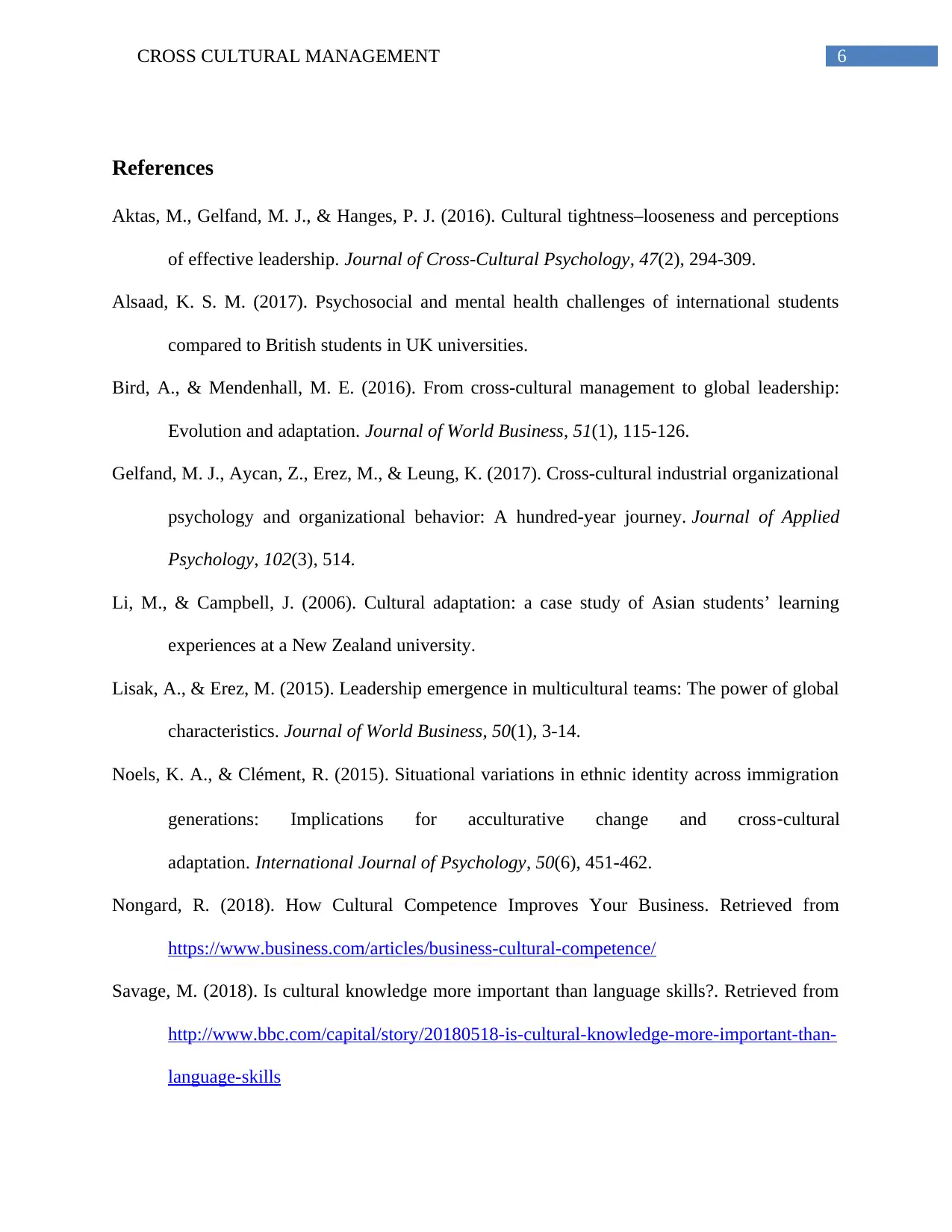
6CROSS CULTURAL MANAGEMENT
References
Aktas, M., Gelfand, M. J., & Hanges, P. J. (2016). Cultural tightness–looseness and perceptions
of effective leadership. Journal of Cross-Cultural Psychology, 47(2), 294-309.
Alsaad, K. S. M. (2017). Psychosocial and mental health challenges of international students
compared to British students in UK universities.
Bird, A., & Mendenhall, M. E. (2016). From cross-cultural management to global leadership:
Evolution and adaptation. Journal of World Business, 51(1), 115-126.
Gelfand, M. J., Aycan, Z., Erez, M., & Leung, K. (2017). Cross-cultural industrial organizational
psychology and organizational behavior: A hundred-year journey. Journal of Applied
Psychology, 102(3), 514.
Li, M., & Campbell, J. (2006). Cultural adaptation: a case study of Asian students’ learning
experiences at a New Zealand university.
Lisak, A., & Erez, M. (2015). Leadership emergence in multicultural teams: The power of global
characteristics. Journal of World Business, 50(1), 3-14.
Noels, K. A., & Clément, R. (2015). Situational variations in ethnic identity across immigration
generations: Implications for acculturative change and cross‐cultural
adaptation. International Journal of Psychology, 50(6), 451-462.
Nongard, R. (2018). How Cultural Competence Improves Your Business. Retrieved from
https://www.business.com/articles/business-cultural-competence/
Savage, M. (2018). Is cultural knowledge more important than language skills?. Retrieved from
http://www.bbc.com/capital/story/20180518-is-cultural-knowledge-more-important-than-
language-skills
References
Aktas, M., Gelfand, M. J., & Hanges, P. J. (2016). Cultural tightness–looseness and perceptions
of effective leadership. Journal of Cross-Cultural Psychology, 47(2), 294-309.
Alsaad, K. S. M. (2017). Psychosocial and mental health challenges of international students
compared to British students in UK universities.
Bird, A., & Mendenhall, M. E. (2016). From cross-cultural management to global leadership:
Evolution and adaptation. Journal of World Business, 51(1), 115-126.
Gelfand, M. J., Aycan, Z., Erez, M., & Leung, K. (2017). Cross-cultural industrial organizational
psychology and organizational behavior: A hundred-year journey. Journal of Applied
Psychology, 102(3), 514.
Li, M., & Campbell, J. (2006). Cultural adaptation: a case study of Asian students’ learning
experiences at a New Zealand university.
Lisak, A., & Erez, M. (2015). Leadership emergence in multicultural teams: The power of global
characteristics. Journal of World Business, 50(1), 3-14.
Noels, K. A., & Clément, R. (2015). Situational variations in ethnic identity across immigration
generations: Implications for acculturative change and cross‐cultural
adaptation. International Journal of Psychology, 50(6), 451-462.
Nongard, R. (2018). How Cultural Competence Improves Your Business. Retrieved from
https://www.business.com/articles/business-cultural-competence/
Savage, M. (2018). Is cultural knowledge more important than language skills?. Retrieved from
http://www.bbc.com/capital/story/20180518-is-cultural-knowledge-more-important-than-
language-skills
Paraphrase This Document
Need a fresh take? Get an instant paraphrase of this document with our AI Paraphraser
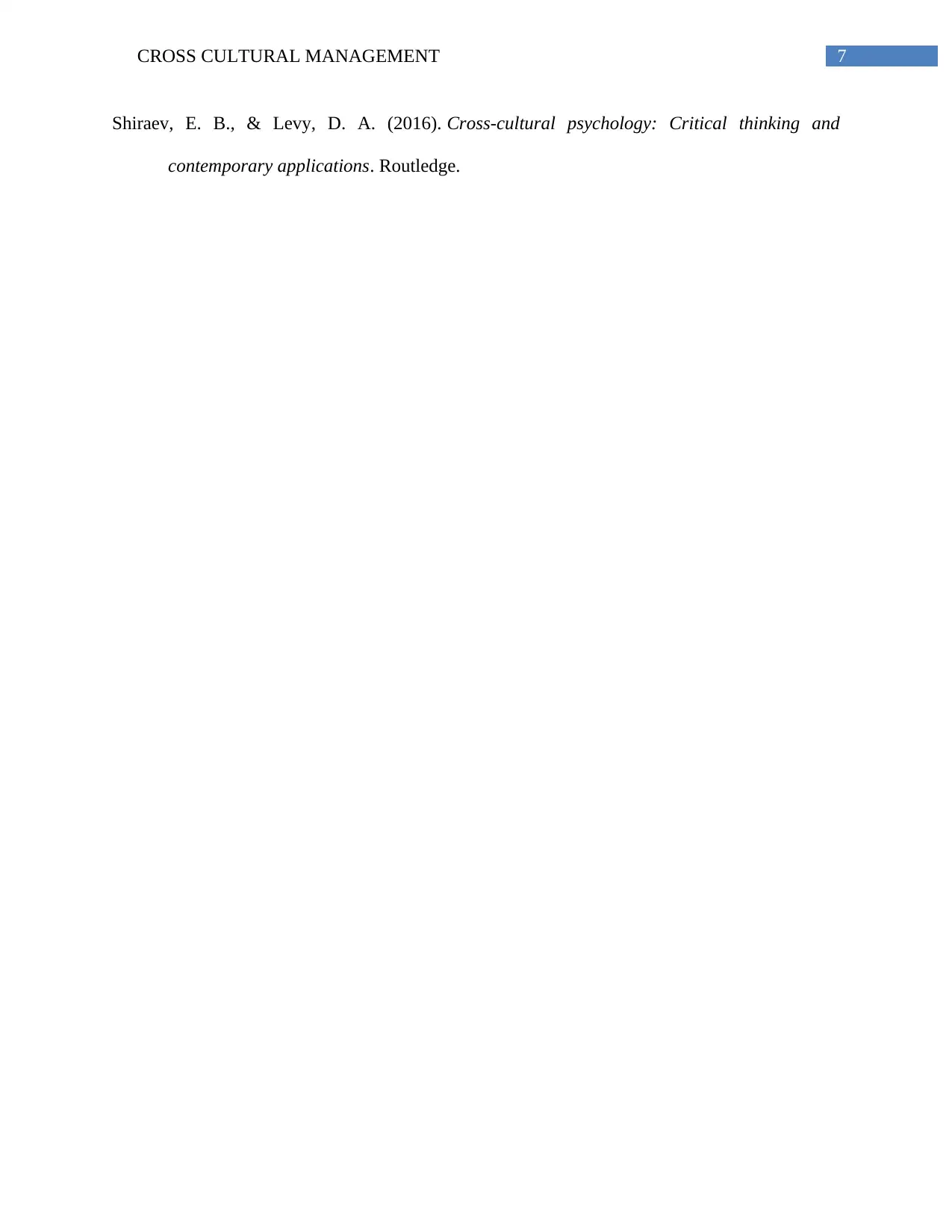
7CROSS CULTURAL MANAGEMENT
Shiraev, E. B., & Levy, D. A. (2016). Cross-cultural psychology: Critical thinking and
contemporary applications. Routledge.
Shiraev, E. B., & Levy, D. A. (2016). Cross-cultural psychology: Critical thinking and
contemporary applications. Routledge.
1 out of 8
Your All-in-One AI-Powered Toolkit for Academic Success.
+13062052269
info@desklib.com
Available 24*7 on WhatsApp / Email
![[object Object]](/_next/static/media/star-bottom.7253800d.svg)
Unlock your academic potential
Copyright © 2020–2025 A2Z Services. All Rights Reserved. Developed and managed by ZUCOL.